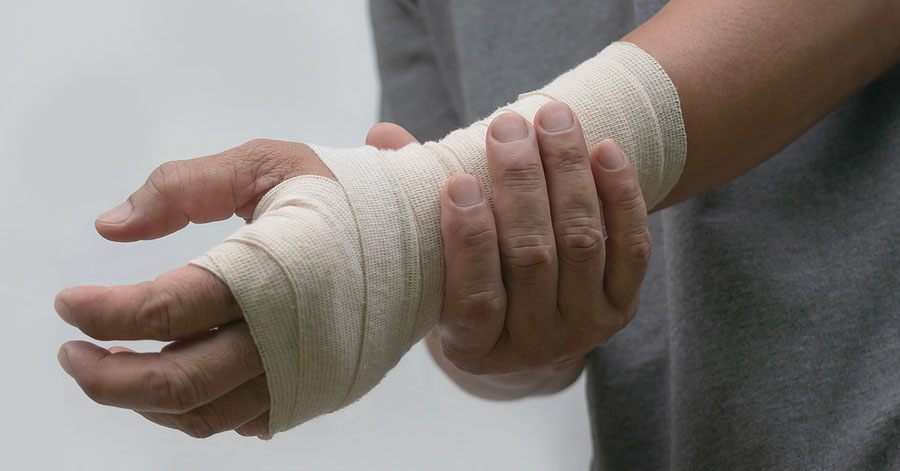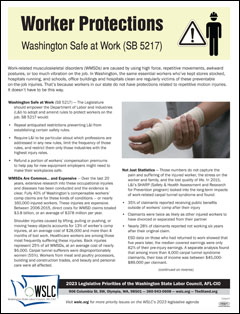STATE GOVERNMENT
Sign-in to protect workers from costly, preventable injuries
The following is from the Washington State Labor Council, AFL-CIO:
OLYMPIA (March 13, 2023) — Work-related musculoskeletal disorders (WMSDs) are caused by using high-force, repetitive movements, awkward postures, or too much vibration on the job. In Washington, the same essential workers who’ve kept stores stocked, hospitals running, and schools, office buildings and hospitals clean are regularly victims of these preventable, costly on-the-job injuries. That’s because workers in our state don’t have protections related to repetitive motion injuries.
It doesn’t have to be this way.

Washington state legislators are considering important workplace safety legislation that would allow the state Department of Labor and Industries (L&I) to adopt and amend rules to protect workers from chronic, preventable WMSDs. SB 5217, known as Washington Safe at Work, would repeal antiquated restrictions preventing L&I from establishing protections against WMSDs. It would require L&I to be particular about which professions are addressed in any new rules, limit the frequency of those rules, and restrict them only those industries with the highest injury rates.
SB 5217 has already been approved by the Senate. On Wednesday, it will get a public hearing in the House Labor & Workplace Standards Committee. That means union members and other supporters of workplace safety need to weigh in now to support of this critical legislation.
 TAKE A STAND — Please click here and sign in as PRO on SB 5217. Go on record as supporting this legislation to promote stronger public health and stronger industries, and to support the retention and wellness of Washington workers.
TAKE A STAND — Please click here and sign in as PRO on SB 5217. Go on record as supporting this legislation to promote stronger public health and stronger industries, and to support the retention and wellness of Washington workers.
BACKGROUND — Over the last 20 years, extensive research into WMSDs has been conducted and the evidence is clear. Fully 40 percent of Washington’s compensable workers’ compensation claims are for these kinds of conditions — or nearly 160,000 injured workers. These injuries are expensive. Between 2006-2015, direct costs for WMSD claims totaled $3.8 billion, or an average of $378 million per year.
Shoulder injuries caused by lifting, pulling or pushing, or moving heavy objects accounts for 13 percent of worker’s compensation injuries, at an average cost of $28,000 and more than four months of lost work. Healthcare workers are among those most frequently suffering these injuries. Back injuries represent 25 percent of all WMSDs, at an average cost of nearly $6,000. Carpal tunnel sufferers are disproportionately women (55%). Workers from meat and poultry processors, building and construction trades, and beauty and personal care are all affected.
But those numbers don’t capture the pain and suffering of the injured worker, the stress on the worker and family, and the lost quality of life. In 2015, L&I’s SHARP (Safety & Health Assessment and Research for Prevention program) looked into the long-term impacts of work-related carpal tunnel syndrome and found:
- 35% of claimants reported receiving public benefits outside of workers’ comp after their injury;
- Claimants were twice as likely as other injured workers to have divorced or separated from their partner; and
- Nearly 28% of claimants reported not working six years after their original claim.
 Employment Security Department data on those who had returned to work showed that five years later, the median covered earnings were only 82% of their pre-injury earnings. A separate analysis found that among more than 4,000 carpal tunnel syndrome claimants, their loss of income was between $45,000-$89,000 per claimant.
Employment Security Department data on those who had returned to work showed that five years later, the median covered earnings were only 82% of their pre-injury earnings. A separate analysis found that among more than 4,000 carpal tunnel syndrome claimants, their loss of income was between $45,000-$89,000 per claimant.
Workers of color are disproportionately impacted by unsafe workplaces. In 2010, SHARP looked at limited English proficient workers with low back disorders in the workers’ comp system, and found they were more likely to perform hazardous work, experience higher rates of work-related injury illness, and have worse disability outcomes. Spanish-language-preferring workers were more likely to have their claims contested by employers and had higher claim costs and more lost time. And the frequency of these injuries is likely higher than we know because workers of color are less likely file a workers’ comp claim due to concerns with documentation, intimidation, threats, and other reasons.
Oregon, California, and New Hampshire already protect workers to prevent injuries like these.
In 2003, the Building Industry Association of Washington (then run by Tom McCabe, current director of the anti-union Freedom Foundation) led a multi-million dollar initiative campaign to repeal an L&I rule intended to protect workers from musculoskeletal injuries. Outspending the rule’s proponents by more than 3-to-1, the rule-repealing measure passed 53% – 47%. But not only did it repeal the rule, the measure included language forever restricting L&I from issuing another one.
In the 20 years since, we’ve learned a lot about the extraordinary costs of preventable WMSDs, both for injured workers’ families and for employers in terms of costs to our workers’ compensation system. We’ve also learned from other states’ experience how better to prevent these injuries from happening.
L&I should not be blocked from protecting workers’ safety. The Legislature should allow the Washington State Department of Labor and Industries to adopt rules dealing with musculoskeletal disorders, informed by social determinants of health and using a racial justice framework.
Please sign-in as a supporter of SB 5217 to give L&I the authority to do its job protecting workers from injury, including costly and debilitating WMSDs.





